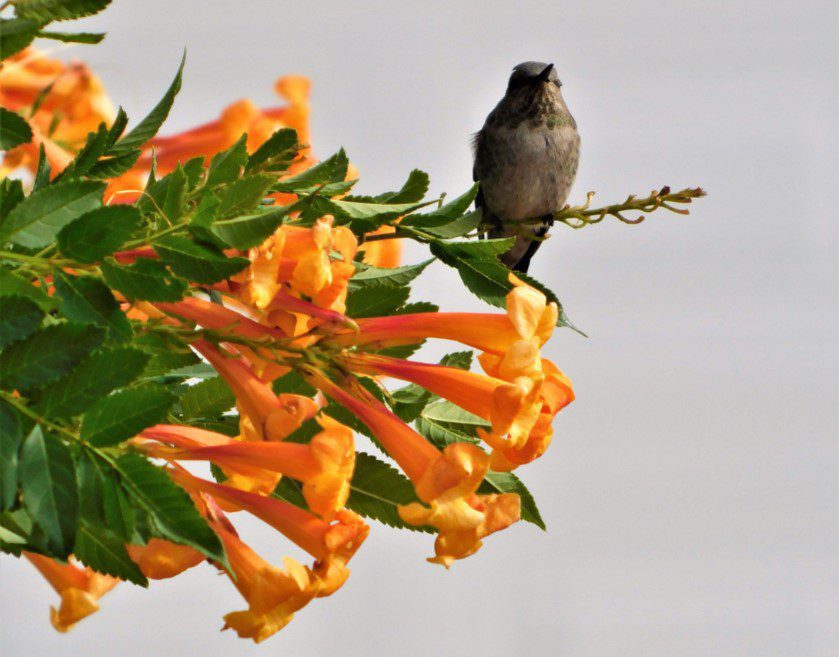Hummingbird Plant

Dicliptera suberecta, commonly known as a firecracker or hummingbird bush plant, is quite a mouthful for such a graceful specimen. Velvety and soft, the gray-blue leaves are accented by coral-colored tubular flowers that bloom from midsummer to late fall.
While hairy leaves usually indicate tolerance to hot sun, specimens of Dicliptera at the Gardens at Heather Farm seem to thrive best with afternoon shade.
It is planted in a giant wine barrel outside my office under the canopy of Raywood ash and is often visited by hummingbirds.
Because of its lax habit (suberecta meaning almost upright), it tends to have a sprawling look when planted in the garden.
It also is planted just outside the lower offices under the deciduous Chinese Tallow trees with Salvia cacaliifolia, a cobalt blue flowering sage that compliments the pale orange color.
Native to Uruguay, Dicliptera is another plant with its botanical name changed.
Once known as Justicia suberecta, taxonomists decided on the characteristics of the floral bract.
Plant species adapted to hummingbird pollination often have owers that are showy orange-red, scentless, have a long, narrow, tubular corolla, and produce a large amount of dilute nectar broadly correspond to hummingbird sensory capabilities, morphology, and high energetic demands.
However, the oral phenotype may vary among populations within the same species.
What Does a Hummingbird Bush Look Like?
Hummingbird flowers are bushy plants that reach 2 feet (1 m.) and spread about 3 feet (1 m.). The velvety leaves and stems are an appealing shade of grayish-green.
Multitudes of bright, reddish-orange flowers at stem tips are upright and tube-shaped, making it easy for hummingbirds to reach the sweet nectar.
This adaptable hummingbird bush perennial is suitable for growing in USDA plant hardiness zones seven and above. In cooler climates, hummingbird plants grow as annual. It is adequate for containers, hanging baskets, flower beds, or borders.
How to Grow Dicliptera
Growing hummingbird bush plants is about as easy as it gets. Plant this drought-tolerant, heat-loving plant in full sunlight and well-drained soil, then sit back and watch the show as hummingbirds flock from near and far.
It isn’t unusual to see several hummers on a single plant. The hummingbird plant is also attractive to other beneficial pollinators, including butterflies and honeybees.
Hummingbird Bush Care
The hummingbird plant is a hardy, indestructible plant that thrives on neglect. Although the plant prefers dry soil, it benefits from occasional water during hot, dry weather.
No fertilizer is required. As a perennial, if you’re growing the hummingbird plant, cut the plant nearly to the ground after blooming ends in autumn.
The plant will lie dormant thru the winter but burst forth better than ever when temperatures rise in spring.
The hummingbird is resistant to most pests and diseases, although the plant may rot in soggy, poorly drained-soil. Deer usually leave this plant alone, probably because of the fuzzy foliage.
A leaflike, often brightly colored organ just below the flower cluster — is more like that of the genus Dicliptera, a genus of 150 species of annuals and soft-stemmed or woody evergreen perennials, subshrubs, and climbers that have angled stems that grow in warm or temperate regions.
Other characteristics include opposite lance-shaped velvety gray-green leaves and slender, two-lipped colorful flowers. It may reach a height and width of about 2 feet and dies back in the winter months.
Dicliptera is prone to rust. As rust thrives in a wet environment and our gardens are low water users, we have not experienced this as a problem.
If rust occurs, remove affected leaves, avoid overhead irrigation, and ensure good air circulation between plantings, giving adequate room for each specimen as it reaches its mature size.
If you didn’t entice any hummingbirds to your yard in the spring, don’t despair. People near wooded areas enjoy the tiny visitors all summer, and those in prairie areas will see them return in August and September when birds refuel for their return to the tropics.
Fall is a perfect time to plant in the garden.


























Comments are closed.